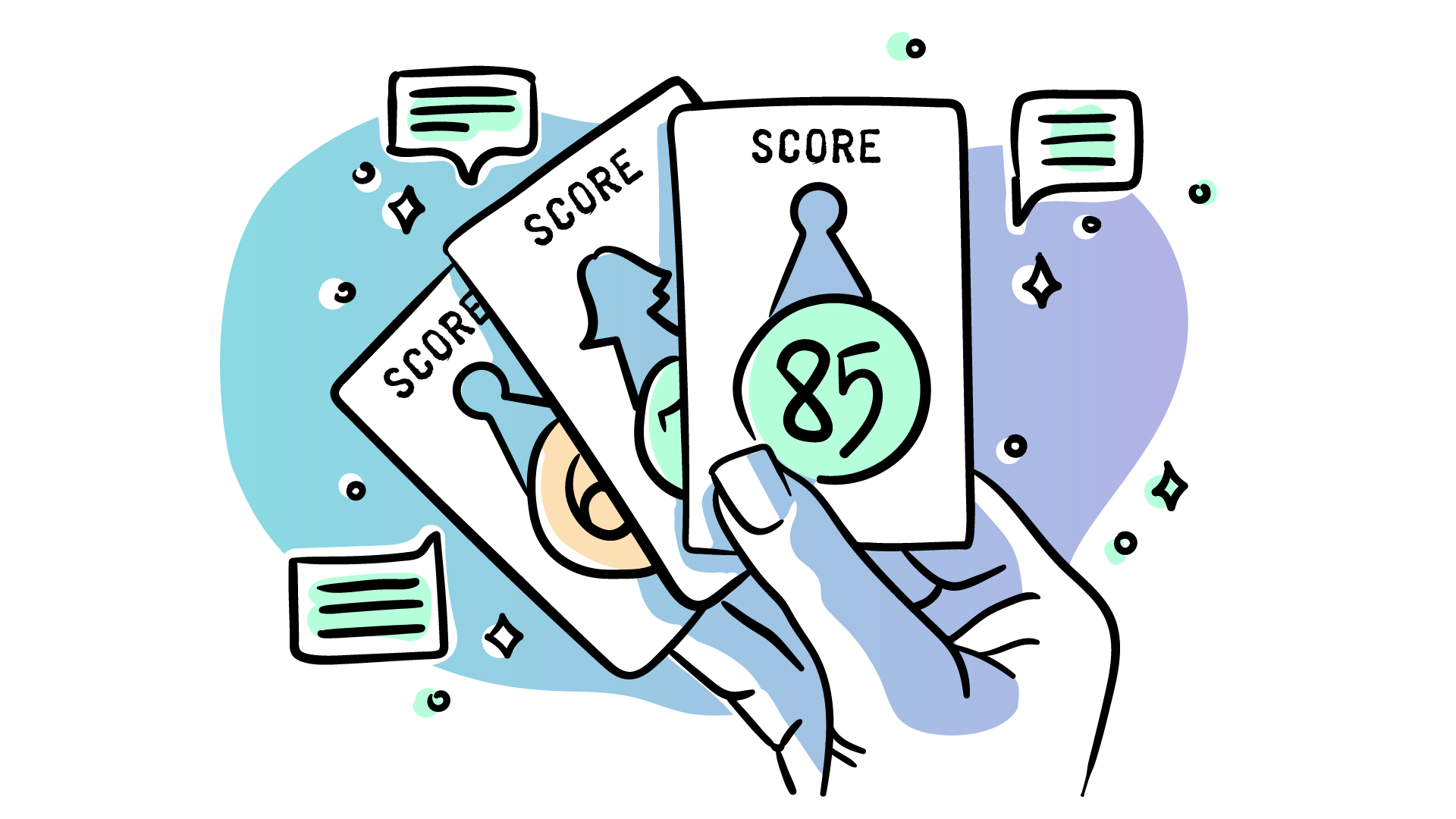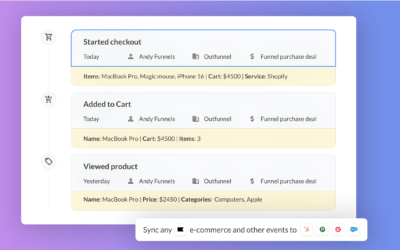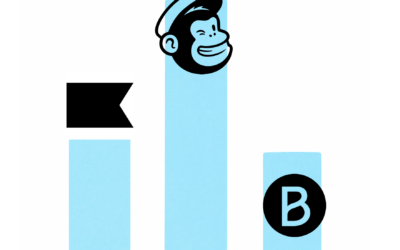If you’re:
- processing thousands of leads manually,
- spending a lot of time on poor-quality leads, or
- experiencing a ton of conversions from your marketing campaigns, but don’t know which leads to prioritize…
… it’s time to implement lead scoring in your business.
But creating a lead scoring model from scratch is easier said than done.
Where does one even begin?
Well, you’ve landed in the right corner of the internet.
In this complete guide, you’ll learn everything you need to know about lead scoring — including what it is, how you can benefit from it, and a three-step process on scoring a lead (featuring lead scoring examples from B2B SMBs).
Let’s dive in!
What is lead scoring?
Lead scores are determined by various attributes – which we will elaborate further in the following section – such as email unsubscribe, web site visits, job title, to name a few.
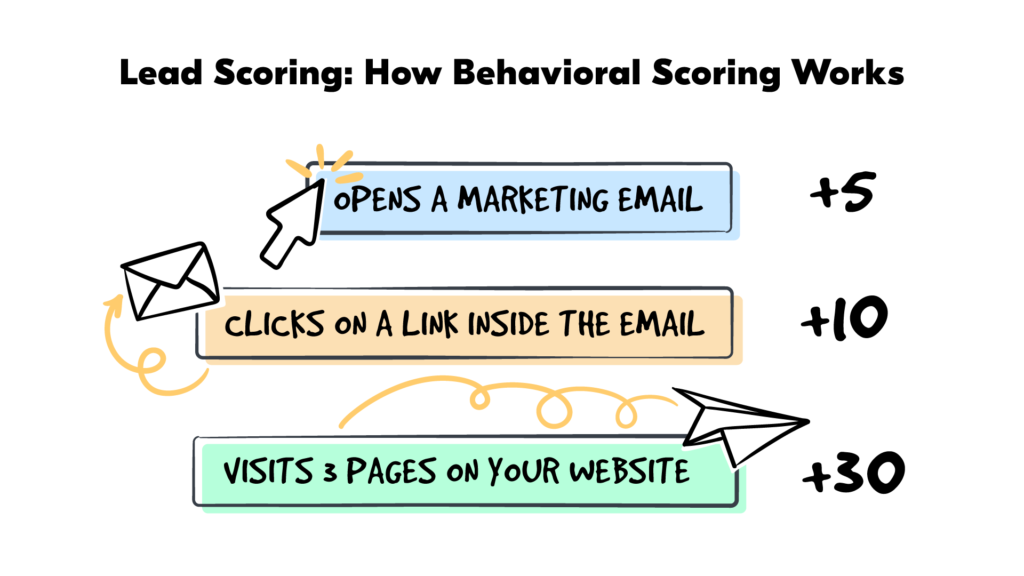
Let’s deep dive into the types of attributes—explicit and implicit attributes.
Explicit lead scoring
Explicit lead scoring is based on data you’ve received from the lead directly. Demographic and firmographic data fall under this category and include attributes such as:
- Job title
- Company size
- Industry
- Location
Implicit lead scoring
Implicit lead scoring is your ability to pay attention to a lead’s behavior. It includes behavioral scoring, active and passive buying behavior. Examples of the type of data you’ll collect in this category are:
- White paper or other gated content downloads
- Web site visits
- Email engagement
- Watching product demos and videos
- Interactions in the sales and marketing funnel such as attending a webinar
For every attribution that applies to your leads, they earn points.
So, a visit to the pricing page could add points to the lead score, as it signals a high buying intent.
Often, the scoring criteria can be configured to lose points as well. For example, an email unsubscribe could subtract points, as it indicates the lead no longer wants to hear from you.
Once a lead hits a point threshold — say, a score of 50 — a sales rep will reach out and close the deal. (Most companies have sales automation in place to highlight such qualified leads to the sales reps!)
Want to go deeper into each attribute? We will tell more about them in the following sections.
Why do you need lead scoring in your B2B business?
Easy: to remove guesswork, so you’d spend time on leads who are the most likely to convert.
Take TeamBuilding, a company that hosts team-building activities.
Before Covid-19 hit the world, lead scoring wasn’t a priority. The company had three sales reps manually following up with leads and treating them all equally.
The process quickly turned messy, as they were only able to contact a fraction of their list.
Fast forward to March 2020, when TeamBuilding launched virtual offerings in light of the pandemic, they saw a massive influx of leads — so massive that they struggled to keep up with the demand.
Fortunately, the company’s process improved after implementing lead scoring. The sales reps were able to focus their efforts on closing “sales-ready” leads and turn their manual process into an automated one.
On top of that, they grew their sales team from three to 12 sales reps and more than tripled their monthly revenue.
At its core, that’s what lead scoring does.
It helps you see how far your leads are down the sales funnel, so you’ll know who to focus on and what’s the best action to take and turn them into customers.
4 benefits of lead scoring that marketing and sales teams can’t ignore
Now that we understand why lead scoring is an essential tool in the B2B buying cycle, let’s take a look at the four main benefits for both the marketing team and the sales team:
1. Lower marketing and acquisition costs
David Morneau, CEO of InBeat Agency, saw a 40% cut in his marketing and acquisition costs after using lead scoring in his business.
Why did it work so well? Because it helped him identify and cut the marketing efforts that drove low-quality leads.
2. Higher conversion rates with less time wasted
Seema Nayak, Marketing Manager at AdChina.io, increased their MQL conversion rate by 25%.
Her tactic? Sales reps only speak to leads with a score of 50 and above. Leads who score below 50 go through an automated lead nurturing email workflow.
3. Increase in sales and marketing alignment
Are your sales reps complaining about the unqualified leads marketing is sending across?
That’s a giant red flag you don’t have an effective lead scoring system, creating a disconnect between the sales and marketing teams.
When you implement a method for scoring leads, you’re ensuring that every lead passed onto sales is qualified in a way that both teams have agreed on, boosting your conversion rate, and strengthening the relationship between the two departments.
4. Higher revenue
Michael Alexis, CEO of TeamBuilding, tripled his monthly revenue after applying lead scoring in his business.
This isn’t a success story that happens once in a blue moon. An elaborate study by Eloqua has shown that, on average, implementing lead scoring systems increases deal close rates by 30%, and company revenue by 18%.
Based on these incredible results, one thing’s for sure: lead scoring drives revenue growth.
How to score leads: a 5-step guide
Now that we’ve got the fundamentals out of the way, let’s take an in-depth look at scoring a lead.
1. Unite and clean up your sales and marketing data
You’ll want to study history if you want to know what will take place in the future, as the old saying goes.
If you want to know which leads have a higher probability to close, analyze what traits and behaviors characterize leads that have already converted.
In order to do that, you’ll want to bring your sales and marketing data together. In large platforms like HubSpot, this is relatively easy. Tools like Outfunnel (yup, that’s us) can help to create 360-degree profiles for leads if your lead data lives across multiple sales and marketing tools.
2. Talk to sales
Researching your customers is just one part of the equation.
Your next action: Talk to the sales team and fill in the gaps. Once you’re done, you’ll know how to score your leads.
Alexa Korach, Marketing Manager at Korn Ferry, outlines a few questions to get started:
Start prioritizing leads and increase led-to-win conversion rates by 25%
Works with Pipedrive, Salesforce, Copper, and HubSpot CRM.
How To Create A Lead Scoring Model
Step #2: Gather feedback from the sales team
2. How many touchpoints do you look for before follow-up takes place?
3. What are high-value pages (e.g. pricing page) on the website that should be scored higher?
4. What are the job titles or companies that should get routed faster?
3. Talk to your customers
Sure, your sales team is a well of valuable information, but there is a small flaw.
The content your sales reps claim converts might differ from the opinions of customers who went through your sales funnel.
To clear up the confusion, take the time to hear from both sides. Schedule in customer interviews and discover what convinced them to open their wallets and click “add to cart”.
Tip: Speak to customers who had long and short sales cycles to get diverse opinions.
4. Map your customer’s journey and key traits
Use the insights you’ve gathered as a reference, and map out your customer’s journey.
Next, list your attributes and allocate points for each value. Here’s an example of how that may look:
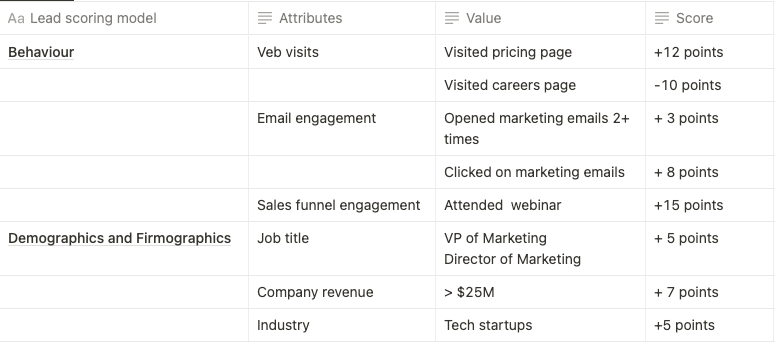
Get as specific as possible. The more detailed your buyer persona and buyer journey description is, the more accurate your lead scoring will be.
Best practices for firmographics and demographics: Using demographic data is considered a little old-fashioned these days, as it is often only related to the personal data that you ask from the lead. The best practice is to ask for as little data as possible from the lead and get “firmographic” data (yup, that’s a thing!) automatically with tools like Clearbit, Madkudu, etc. For example, Supermetrics shared with us that they use product-based activities enriched with Clearbit data for their lead scoring.
We’ve enriched our data with Clearbit and discovered there were no strong firmographic signals we could use in our lead scoring models.
Best practices for web behavior: Using online behavior for lead scoring is a no-brainer these days, as it is just basic analytics with a laser-sharp focus. Make sure the lead scoring software you use is configured to track whatever pages or actions that show high intent and you’ll save tons of your salespeople’s time with lead scores. For example, Caddle uses Outfunnel’s lead scoring feature for this.
Best practices for email behavior: Email engagement, especially email clicks can be a brilliant indicator of lead intent. One of the best practices for using email engagement for lead scoring rules is to set the points to expire after a while. This is called score degradation. It helps you track stagnant leads and improves your sales productivity by keeping reps focused on prospects who are actively engaging with your brand. After all, if it’s been weeks or months since the lead last engaged with your emails, the points don’t really indicate intent anymore.
5. Use a lead scoring tool to automate the calculation
Now that you know which attributes to focus on and how much to assign for each value, you might be wondering: how does this look in a lead scoring software?
In this section, we’ll use Outfunnel (yep, that’s our tool!) to give you a taste.
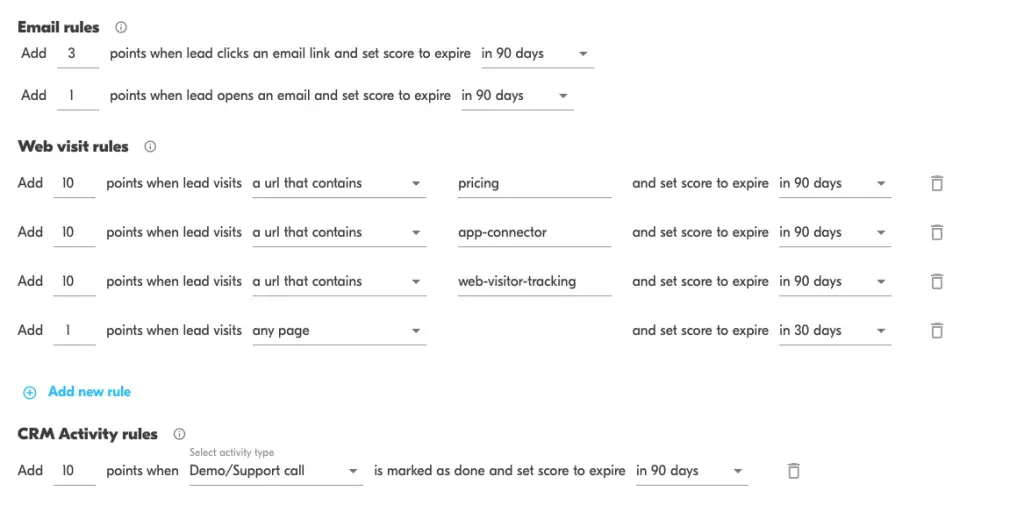
With Outfunnel, you can automatically score leads based on their web visits email engagement, as well as events and field content from your CRM, and sync it back to your CRM (works with Pipedrive, Salesforce, Copper, and HubSpot).
Thanks to context, it’s easy to access your leads’ sales, web, and email engagement in one place.
What this means: you can set up hyper-targeted email sequences to your CRM contact lists once (e.g., automated follow-up email to a lead who converted to a customer), and then just set up a workflow to hand leads with sufficiently high lead scores over to sales.
Learn more about Outfunnel’s lead scoring software or check out our top integrations:
- Lead scoring for Pipedrive
- Lead scoring for HubSpot
- Lead scoring for Salesforce
- Lead scoring for MailChimp
Pro tip: always be improving
Follow up with your sales team with these questions and tweak your lead scoring model accordingly:
2. Are too many (or too few) leads hitting the scoring threshold?
3. Are you seeing leads who aren’t warm enough?
[Case Study] How a B2B events company uses lead scoring
TeamBuilding (the company we explored earlier in this post) focuses on just two attributes: Group size and event date.
The event company uses the custom fields in their contact forms to gather variables from the lead and uses Zapier to sort them in priority channels on Slack (P1, P2, and P3).
How do the sales reps decide which leads to follow up with first? They look at the — you guessed it — group size and event date.
The earlier the date and the larger the size, the bigger the priority.
As you can see here, there’s no one-size-fits-all lead scoring model.
Your business, buyer persona, and feedback from the sales team (more below) will determine your lead scoring attributes and values.
Read more about 7 lead scoring best practices with examples here.
3 advanced lead scoring models to optimize your process
Earlier on, we introduced you to three common rule-based lead scoring models.
Now… What if you want to optimize your process and capture even greater leads? Here are two advanced lead scoring models worth baking into your strategy:
1. Social influence
Well-known professionals open up doors to partnerships and affiliate endorsements.
Look for social influencers with a large following on social media and create an A+ customer experience (think: assigning a dedicated salesperson, offering exclusive perks, etc.).
“Suppose a brand prioritizes reaching out to a well-known marketer to try their SaaS marketing software. If they like it, this brand gets free endorsements and a detailed review of their positive experience. The benefits are enormous.”
Sherry Mae, CMO of Tankarium
2. Urgency
An increased frequency of website visits indicates the lead’s at the last stage of the buying journey.
Build this “readiness to buy” in your lead scoring model and watch those conversions soar.
InBeat Agency did exactly this and conversion boosted by 15%.
3. Spam & Negative Scores
Not every lead is worth your time.
Some potential prospects are your competitors snooping around, others are users that don’t fit your ideal customer profile and some are leads that are showing a lack of interest.
Negative scoring is a way to separate high-value prospects from those least likely to convert by removing points.
How does it work?
You can flag a set of specific actions and characteristics that indicate a lead isn’t worth your time.
For example:
- Unsubscribing from your email list.
- A generic personal email address like Gmail or Yahoo (if you’re selling to businesses).
- Using a job title or industry that isn’t aligned with your ideal customer profile.
- Form fields containing repeating letters or characters that indicate spam.
Once you have your set of actions, assign a negative point value to each one
Not sure how to weigh your scoring? Use a larger number for the traits and actions that are most common across lead who have left your pipeline.
Predictive Lead Scoring
Once you have a lead scoring system in place, the final tool you need in your toolkit is predictive lead scoring.
What is predictive scoring, and why is it important?
It’s a lead scoring system powered by artificial intelligence (AI) and an algorithm that learns the patterns of past customers to predict when a lead will make a purchase.
Instead of your marketing or sales departments trying to determine what leads to focus on, predictive scoring does all the heavy lifting.
The best part?
The more customers you convert, the more data you have to feed the algorithm, and the more accurate its predictions.
Conclusion: use lead scoring to spend more time with “ready to buy” leads
There’s little point in investing a lot in lead generation if you’re not segmenting the leads to figure out which leads are high quality and warm.
When you implement lead scoring in your B2B business, you create a continuous feedback loop between sales and marketing teams, and revenue skyrockets.
Lead scoring takes the guesswork out of figuring which leads are ready to buy (and which aren’t), saving you loads of time in the process.
There’s an urgent need for sales and marketing integration in B2B businesses, and yet most tools out there are far too expensive and complicated for SMBs.
If you’re looking for an affordable and easy-to-use lead scoring tool that works with your CRM, we got what you need. Ready to align your marketing and sales efforts? Start your free trial with Outfunnel today.
Start scoring leads with Outfunnel
Works with Pipedrive, Salesforce, Copper, and HubSpot CRM.

